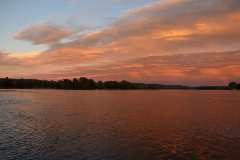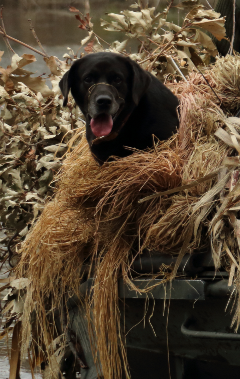Storytelling is critical to getting more people involved in your local conservation work, from monitoring water quality to restoring wildlife habitat. We asked author and videographer Kris Millgate to share her tips on successful storytelling.
– Samantha Briggs, Clean Water Program Director
The sky is empty of clouds and full of birds. Reeds scratch the boat’s belly as it motors across the humidity-soaked backwaters of the Mississippi River. The driver is confident. So are his dogs.
Did you see the sky? Hear the reeds? Smell the river? Imagery creates connection. Connections lead to action. As an Ike, you’re passionate about natural resources. The way you talk about them should be just as passionate.
Your outdoor adventure, whether it’s stream monitoring or river running, is worth talking about. It’s worth even more when it’s compelling enough to inspire others to take action. Inspiring someone to conserve our woods and waters requires a story to “pop” or P-P-POP – sound present, evoke a place, be personal, and offer an opportunity and a punchline. Your PPPOP elements don’t have to be delivered in that order, but they need to be delivered at some point if you expect your story to matter to others.
Let’s break down these elements of good storytelling.
PRESENT
Past tense is dull. Present tense is exciting – it puts your audience in the moment.
“The sky was empty of clouds and full of birds.” The person you’re talking to hears “was” and thinks, “I’d like to see that, but it’s done. Why am I still listening?”
Try this instead: “The sky is empty of clouds and full of birds.” The person you’re talking to hears “is” and thinks, “I’m in this right now. What’s next?”
PLACE
Setting the scene is best done early in the story. You want people to picture what the moment looks like, sounds like, smells like. Do that with descriptive words. Avoid waxing on with too much detail but add enough definition to create a sense of place.
“Reeds scratch the boat’s belly as it motors across the humidity-soaked backwaters of the Mississippi River.” Ride in a boat once, or drive on a road that’s overgrown with weeds, and you know the sound of plant life rubbing the undercarriage. There’s also action in this sentence. We’re motoring across water, and not just any water – it’s humidity-soaked backwater. See the moisture in the air? Feel it stick to your skin? That’s putting your audience in a place.
PERSONAL
Reveal something personal without sounding self-centered – an intimate detail, an awkward behavior, a secret of sorts. You need it because the personal touch humanizes you.
Volunteer stream monitors do amazing work, but some of the science behind their work is over the untrained person’s head. Make your knowledge accessible by getting personal. You’ll see what I mean when you read Underestimating the Mighty below.
See that? I’m getting you interested with a teaser. But don’t skip ahead to my Mississippi River story yet. We have two more elements of storytelling to discuss.
OPPORTUNITY
This is the reason you’re sharing your story. You want others to care about the environment as much as you do. Deliver your conservation message with a delicate but efficient strike. You’re not lecturing your listener. You’re just visiting with them, telling them about your experience and why it matters – and not just to you.
It matters because it speaks to larger natural resource issues. This is your opportunity to create in others a commitment to conservation – or, at the very least, the desire to change conditions for the better – and invite them to get involved!
PUNCHLINE
Make it brief, make it matter, then close your mouth. If your story is told right, the listener will want to speak. Let them. They’ll have questions. Better yet, they’ll have their own story to share with you.
Your closing can be funny, as punchlines traditionally are, but humor isn’t mandatory when you’re going for memorable. Surprise and irony work well as endings. So do verbal invitations to join your next volunteer event. That’s an action ask without beating around the bush.
With your closing delivered while staying open for questions, you just created an exchange – an interaction between people that leads to action.
Watch for the PPPOP in my story below. You know what to look for – and now you know how to make your own stories “pop” to engage more people in your conservation mission.
Underestimating the Mighty: Touring the Mississippi with Duck Dogs
By Kris Millgate
The sky is empty of clouds and full of birds. Reeds scratch the boat’s belly as it motors across the humidity-soaked backwaters of the Mississippi River. The driver is confident. So are his dogs. But I’m not confident – I’m ashamed. I underestimated the “Mighty” and it took me a week to realize it.
I’m on assignment for the Izaak Walton League of America. I’m documenting what the Mississippi River means to the people who work and play along it.
So far, what I see, hear, touch, and smell is just as I expected: unappealing.
The Mississippi is a working river. Over-working is more precise. There’s no union keeping its hours low and its value high. There’s no limit on its use, and the strain of such a burden is barging through the Mighty Miss like its supply is endless, but it’s not. That’s why I’m here. I need to find something worth celebrating.

I spend an evening on the river with Jeff Janvrin. He’s a fisheries biologist for the Wisconsin Department of Natural Resources. He knows where to park his research boat for the best view of the show overhead. In the fall, everything that flies flushes up toward the nation’s notorious flyway – nature’s version of air traffic for whatever heads south ahead of winter. My lens is aimed at the sky as huge flocks float like a wave of arms started by fans in a football stadium. Jeff offers play-by-play of the action, then provides backstory like this waterway has a highlight reel.
“It is a river of commerce. It is a river of recreation. It is a river of inspiration,” he says, skillfully steering his shallow vessel through stringy stems of marsh grass. “If we don’t take care of this resource, what kind of message does that send to the rest of the world?”
I watch wings one night with Jeff, then seek those wings the next morning with duck hunter Mike Griffin. He and his dogs are thrilled to be out. I’m just tired. I’ve listened and I’ve looked for a week, yet my thoughts are still muddied by my preconceived notion of a worn-out artery twisted by human neglect.

Then Lilly, an 11-year-old black Lab, pokes her head out of Mike’s branch-buried boat. She has cataracts in her cloudy blue eyes. Though her view is murky, she proudly pops her head through the peephole, looking out over the water. Ash, an 18-month-old Lab, tries pushing Lilly out of the way, but she won’t give. Ash won’t have the duck boat’s peephole until Lilly’s done. She performs as expected, regardless of her cloudy eyes.
I stare at the aging dog with her gray muzzle. I’m admiring her feeble eagerness when my head clears like Lilly’s eyes never will. Like Lilly, the river refuses to yield. For centuries, people have tried manhandling it – damming and directing it – but it won’t tame, running proudly from Minnesota to Louisiana.
“The Mississippi is everything to everybody,” Mike says, idling the boat next to a recently restored bog. “This is the lifeblood of America.”
America’s lifeblood works for people – the industrial and the recreational kind. It also works for wildlife – the staying and the migrating kind. Its beauty is in its usefulness and its ability to keep going. That’s why we need to treasure it and conserve the dignity it has left. Shame on me for not recognizing that the first day.
Now I see the Mississippi. It took a duck dog with poor eyesight to show me, but now I really see it. Never underestimate the Mighty.
5 Tips for Storytelling With Your Phone
Adding visuals to your conservation message
You’ve figured out how to use words in a way that matters. You can tell because your audience is engaged. They’re listening. Now get them looking. Show people the natural resources you’re talking about by using the camera on your phone as your visual messenger.
Scroll through a few photos while you’re talking in-person (no more than five, though – you don’t want people to feel like they’re sitting through your family vacation slide show). If you have a really compelling video, show them a quick clip. Photos and video are also critical if you’re sharing your story online.
Here are five tips for giving your message more visual “volume.”
1. Choose your medium
Before taking photos or a video, think through the ways you could use the images – it affects how you shoot. Horizontal videos and photos work well for Facebook but not on Instagram. Instagram’s primary purpose is phone screen viewing, and phone screens use vertical layout. If you post a horizontal shot on Instagram, the sides will be cropped off.
The way you hold your phone determines the shape of what you shoot. Holding it horizontally creates photos that are the shape of postcards and video sized to the rectangular, widescreen look of traditional film. Hold your phone vertically, and what you shoot will be shaped like a magazine cover. Same result with video – it will be tall rather than wide.
2. Consider mode
Some subjects are more powerful when shot as video. Raging whitewater is roaring for video. So is a plowing tractor and kids rolling in grass. A frozen lake, a parked tractor, and kids sleeping in grass? Those are snapshots, not video.
Give yourself a few seconds to study what you want to capture. If it’s not moving, go with photo mode. If it’s action packed, roll video.
3. Listen while looking
Open your ears while you’re studying the scene. Hear anything? If not, chances are nothing is moving. Choose photo. If noise surrounds you, key in on the sound that goes with your visual.
For example, if you want to shoot video of a creek next to a busy road, the traffic noise can drown out the natural gurgling sound of the water. Wait for a gap between cars. You’ll hear the creek clearly in those few moments between vehicles. That’s when you record.
4. Hold still
Regardless of how many shaky videos you see online, it’s uncomfortable to watch and it’s distracting. What you’re trying to show comes across much clearer if your shot is steady. Try holding your breath as you hit record. Then hold still. The water should be moving, not you. You can also buy an inexpensive tripod with an attachment that holds cell phones to keep shots steady.
5. Press record
The hold-your-breath method works, and here’s why: your shot is short. Press record then count to 10 in your head. If you’re shooting video of repetitive action, like waves, you’ll capture the rhythmic sound of three small waves hitting shore in 10 seconds.
The same holds true for wood chopping and bird calling. If you find your photos are coming out blurry, try this method for those too.
Attention spans in this modern age are alarmingly short. Offer your message as a look-and-listen experience of less than a minute. Instagram won’t let you upload videos longer than that anyway.